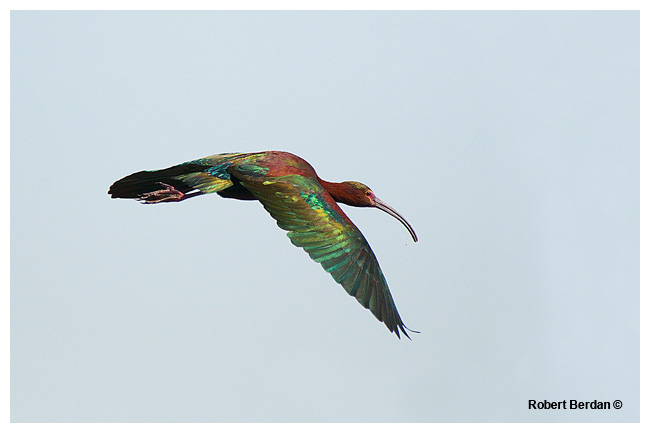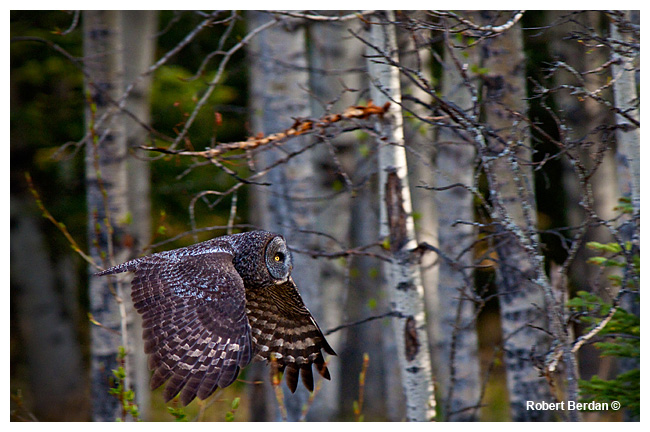
How to Photograph Birds in Flight
by Dr. Robert Berdan
May 24, 2010
Download PDF of article published in BRAGG about the Creek Magazine, Sept 2010

Great Gray Owl photographed near Millarville, AB Nikon D300 300 mm lens + 1.5X teleconverter, 1\640 sec, ISO 1000.
Who ever said that equipment doesn't matter never tried to photograph birds in flight - equipment does matter and your camera settings and choice of lenses are important. A digital single lens reflex camera that will shoot at a high frame rate is helpful as is the choice of telephoto lens. The cameras I have had the most success with are the Nikon D2X (5-8 fps), Nikon D300 (8 fps), and Canon 50D (6 fps). Many cameras offer different shooting modes. I set my camera to its fastest shooting mode (CH or continuous high) and use release priority for best results. Your camera may also offer different modes of focus tracking. With my Nikon cameras I set them to Dynamic autofocus -9 points and focus tracking to short so that when the distance to the subject changes abruptly, the camera waits for a (long, normal or short) period of time before adjusting the focus. I use the short setting so it updates the focus quickly. The faster your camera is able to focus, track and shoot the better your chances. Two additional ways to increase the speed at which your camera will shoot is to use an attachable battery pack and high performance batteries (e.g. with Nikon use the EN-EL4 lithium batteries for a boost in shooting speed). Another way is to shoot your image files as JPEGS, this will also boost the camera's buffer size so you can shoot a greater number of pictures in a single burst. Even so I generally prefer to shoot in RAW format so I can adjust exposure, white balance and enlarge the image afterwards. I also leave the camera meter mode in Automatic (i.e. matrix or evaluative) most of the time. The intensity of the light will also affect your shooting speed. I would recommend start by practicing or shooting in bright sunlight with a blue sky as a background.
Young Osprey, Castle Junction, Banff National Park, AB Nikon D300 300 mm F2.8 lens, ISO 2000, 1\4000 sec.
Your biggest challenge will be to keep a fast moving bird in focus. The wider the aperture of your telephoto lens the faster it will focus on moving subjects - I generally use my lenses wide open. My favourite lens is the Nikon 300 mm F2.8 VR lens which even focuses quickly with a 1.5X tele-converter attached. The F2.8 lens is heavy so you may have to work on your arm strength or eat more spinach. Alternatively you can use a monopod or tripod with a swinging Wimberley head, but I found that the flight of many birds is erratic so I prefer hand holding most of the time. A smaller very quick lens for bird photography is Canon's 300 mm F4 which works well even with a 1.4X teleconverter. Another thing you can do to boost the autofocus speed of your telephoto lenses is if they have a distance limiter - turn the switch on to limit the focus range. Also do not attach a polarizing filter as it will slow down your lens and in my experience prime lenses focus faster then zoom lenses.
White-faced ibis, Frank Lake, AB - Nikon D300, 300 mm lens + 1.5X teleconverter, F4.8, ISO 1000, 1\8000 sec .
No matter what type of lens or camera you use, to get sharp pictures of birds in flight requires a shutter speed of 1\500 of a second or faster. You can achieve faster shutter speeds by increasing the ISO speed on your camera or shooting in bright light. The downside of increasing your ISO speed is that your will have more grain or noise in your pictures, but recent camera models are able to create fine-grained images at ISO speeds of 1600 or greater. Keep in mind that even with the best equipment, the photographers skill at keeping the bird over the autofocus sensor is important so practice shooting fast moving subjects and learn to anticipate when a bird might begin to fly. It's a lot easier to focus on a stationary bird that then takes off then it is to try and lock focus onto a fast flying bird. My camera's autofocus seems to be able to lock on to birds that move horizontally better then those flying toward or away from me. When possible with large birds I always try focus on the animals eyes. If you know the direction the bird will fly try to put the bird in the center of your autofocus sensor or place the bird on one edge opposite to its direction of flight. One can always crop the picture after wards if you captured the whole bird in the picture.
Great Gray Owl, near Millarville, AB Nikon D300, 300 mm lens + 1.5X teleconverter, F4.8, ISO 1600, 1\640 sec
If you want to try photographing birds in flight I suggest starting with big birds, or birds that hover or soar slowly. Hawks, pelicans, swans and Canada geese are ideal. Go to places where birds congregate to improve your chances of finding birds. Blue sky days are ideal as there is usually more light and it will help you avoid getting bird silhouettes. Then as you improve at capturing large birds try you skills with smaller faster moving ones - I am still struggling with small flying birds. Some photographers will photograph birds near a feeder or food source, and others will bait owls with mice to capture them as they fly toward a source of food. The practice of baiting owls with mice is controversial among nature photographers and some feel strongly that it should not be done, though baiting is used to band birds and some owl experts (e.g. Dr. Wayne Lynch) feel that it does not harm the bird and may even help the birds survival. I participated in baiting an owl once and was thrilled with the results, but after researching how it was viewed I have decided not to do this anymore though I don't believe the practice is harmful to the animal and I have not found research studies suggesting that it might be. I even recently watched a movie by National Geographic which showed the photographer using an infrared beam and a live mouse to capture barred owls flying in toward the camera. My pictures show that you can capture owls in flight without baiting, but it requires much more time and patience and I have never had an owl fly straight at me. The pictures of owls shown in this study were taken by simply observing the birds hunt naturally for food - it only took a high speed digital camera and 35 years of practice!
Red-tailed Hawk, Nikon D300 300 mm F2.8, ISO 100, 1\1250 sec.
In Summary 10 Tips to improve your chances of capturing birds in flight
1. Use a digital camera with 5 frames per second or faster
2. Use an autofocous telephoto lens with F2.8 or F4 aperture and turn the focus limiter on
2. Set your camera to Continuous High (CH) shooting mode
3. Set the Autofocus to AI Servo (Canon) or Dynamic AF (Nikon)
4. Use a shutter speed of 1\500 of a second or faster - boost the ISO speed if necessary
5. Start with large or medium sized birds that are moving laterally or fly in circular patterns
6 Start by focussing on birds that are not moving and then try to follow them as they take off
7. Anticipate the direction the bird might fly and position the bird in the center of your frame or on the side opposite to that in which you think the bird will fly.
8. To increase the camera's burst rate use extra battery packs or shoot your files in JPG mode
9. Visit locations where birds congregate like marshes so you have lots of birds to practice on
10. Learn as much as you can about the biology of the bird so you can find the birds and anticipate their behaviour
Tundra swans near Canmore, AB - start with trying to photograph large birds in flight
Great Gray Owl in snow storm near Bragg Creek, AB , I had to focus manually because of the heavy snowfall. Nikon D2X, 300 mm + 1.5 X Teleconverter, F4.5 , ISO 200, 1\1000 sec.
Great Gray Owl near Millarville, AB - Nikon D300 300 mm + 1.5X teleconverter, ISO 1000, 1\800 sec
American Avocet, Frank Lake, AB - Canon EOS 5D 300 mm F4 lens set at F8, ISO 400, 1\1600 sec. Female is on top it has a slightly shorter and more upturned bill.
White-crowned Sparrow, Waterton Lakes NP, Nikon D2X 300 mm F2.8, ISO 100, 1\1500 sec. I am working my way down to smaller birds!
If you find your reflexes are not as quick as you remember try having a cup of coffee before you go out to shoot, the caffeine can increase the speed of your reflexes by 3-5% - no kidding.
[ Top ]








